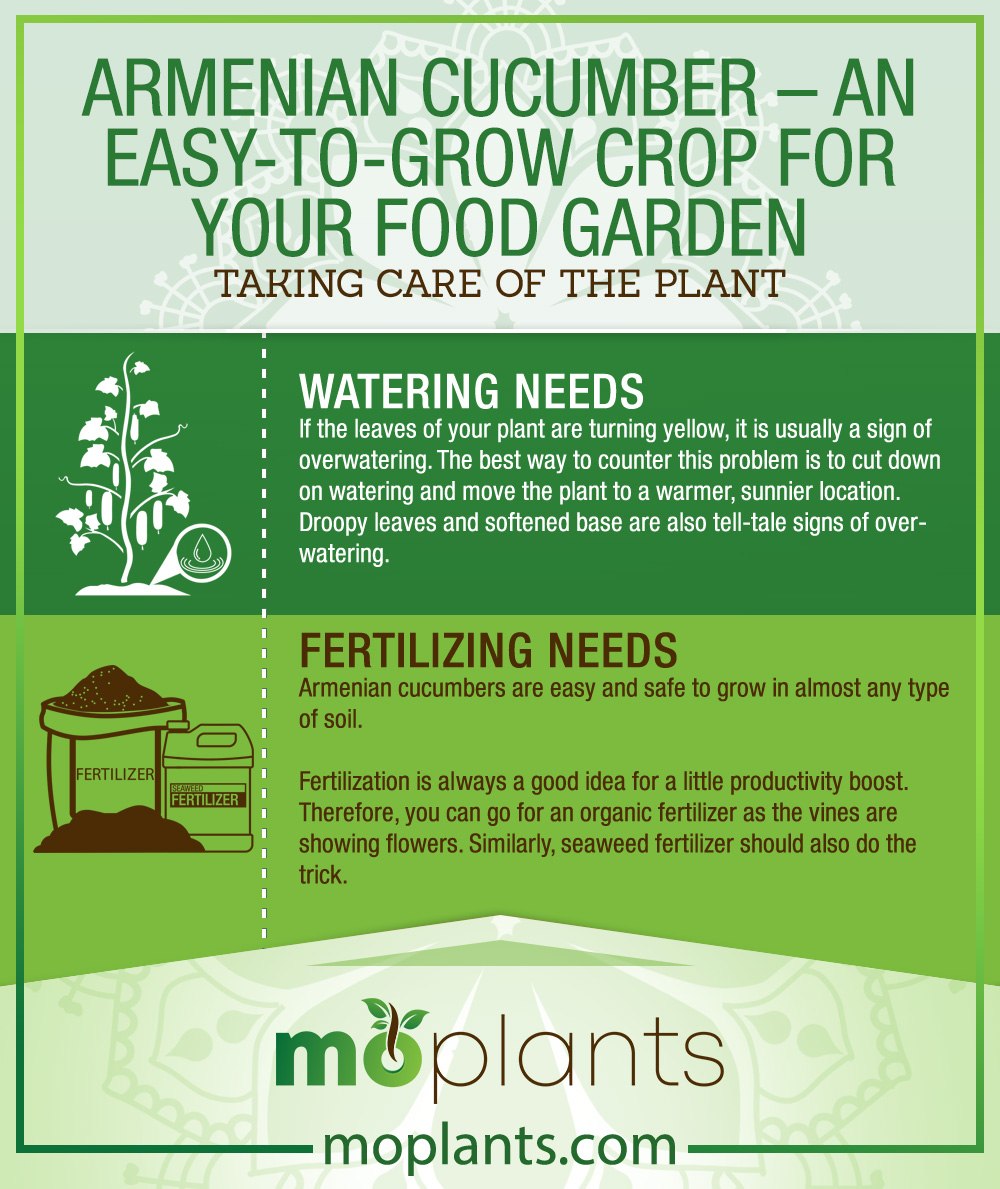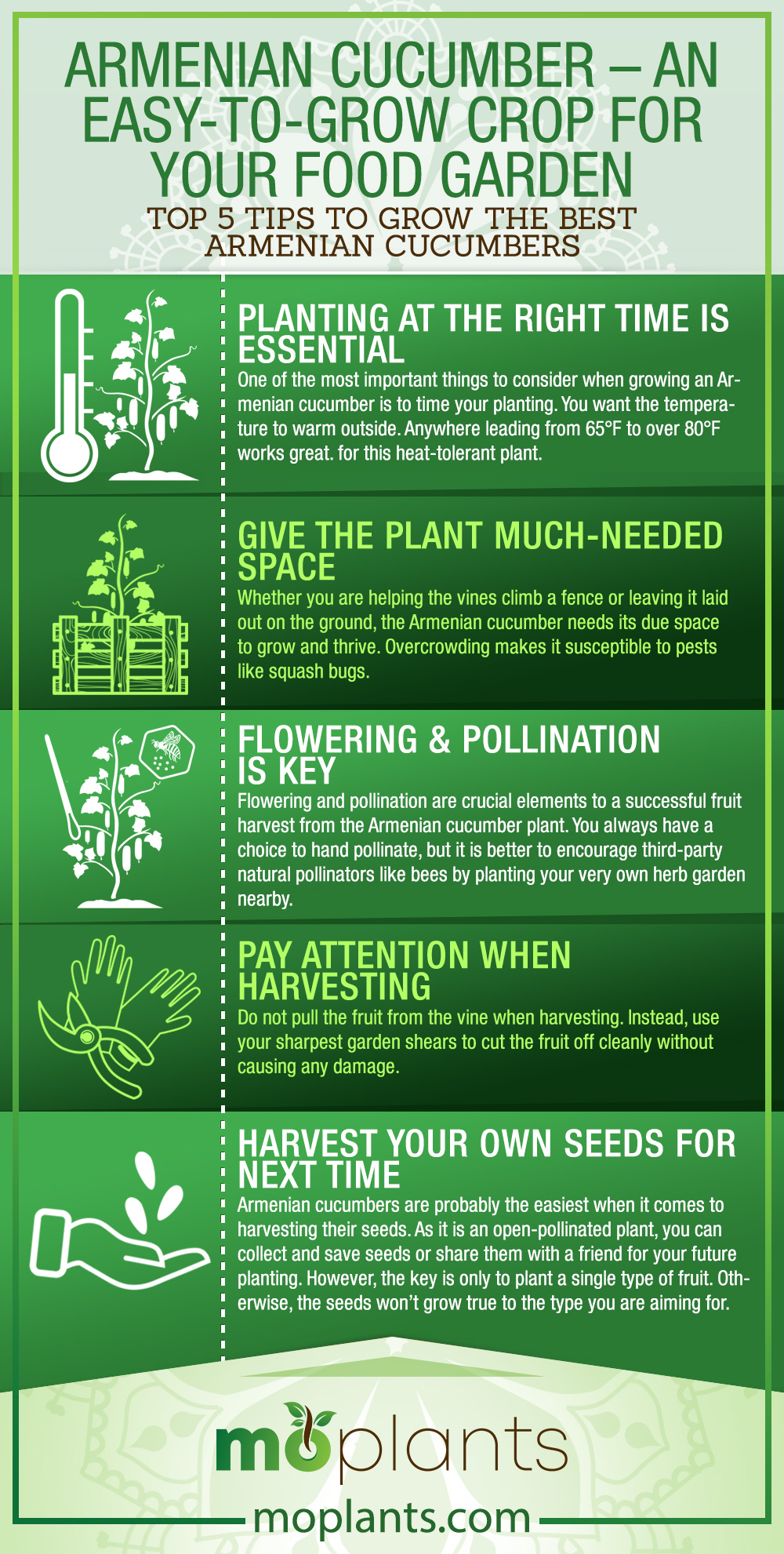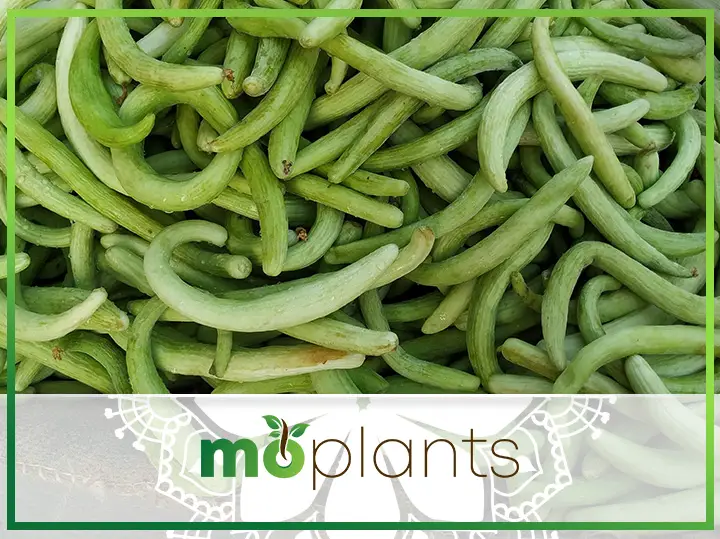The Armenian cucumber, or Kakadi as it is popularly known along the sub-continental coastline, is a humble, easy-to-grow fruit from the muskmelon family. Shockingly, it looks and tastes somewhat like a cucumber – making it a staple ingredient in many Asian cuisines.
It has many names as it spread its roots across several parts of Asia. Hence, it is known as the yard-long cucumber, snake melon, cucumber, etc. It is also called Uri in Japanese, Tarah in Arabic, Metki in Lebanon, and Chanbar in Persian.
One of the best qualities of the humble Armenian cucumber is that it is heat tolerant. This means that no matter how high the temperature gets, your plant will safely suffice. The plant has a growth spurt resulting in long, vigorous vines that require space in the garden.
The long, slender fruit is the result of a healthy plant that tastes like cucumbers and is mildly sweet and hardly ever bitter. It has a crisp texture and thin skin, making it the perfect snacking fruit, thoroughly enjoyed by people to be eaten raw.
The unique fruit plant can be a beautiful addition to your food garden as the plant bears flowers too. You can ensure a steady supply of your homegrown Armenian cucumbers to beat the heat this summer.
Origin
As goes the name, Armenian cucumbers were first cultivated in Armenia around the 15th Century. However, this fruit was exclusive to the Armenian soil for a long time as somebody had yet to carry the plant elsewhere.
Therefore, a few years down the line, Armenian cucumbers were brought to Egypt when migration and traveling among the East Asian countries became a norm. Known as Atta in Egypt, the people loved the fruit variety and it soon became popular.
This led to it being grown in different places. As the plant is very easy to grow and requires warm weather to be planted – it was a successful planting expedition for more Asian countries. Today, it can be grown up to three feet in length and is popularly harvested as a summer pantry staple.
Planting Armenian Cucumber Seeds
It is fairly easy to directly seed the garden for Armenian cucumbers. However, you can always go for a head start indoors. As they are nearly cousins to the regular cucumbers, they take around the same time frame for the complete harvest, i.e., 70 days.
The best time to plant the seeds is important to note, as this can be the make-or-break step of having a successful harvest. Therefore, check around a month before the last expected low temperature of the spring season and use it to your advantage for planting the seeds.
Armenian cucumbers thrive under heat. Hence, planting them indoors and using grow lights to speed up the germination process works well. As soon as you can note that the seeds have started to harden, carefully transplant them to your garden and wait for the last frost.
Growing the Vines Vertically
While the plant requires space and can grow laid flat to the ground, it makes sense that one would want to grow the vines vertically. This way, the plant becomes compact, allowing you to have maximum space for a successful growth spurt and harvest.
Moreover, growing the vines vertically has much less chance of pests, contamination, and diseases. In addition, once the vines bear fruit, they will beautifully hang from the vines, making them easy to spot instead of you having to look under a tangle of leaves.
It is important to note that trying to grow the vines vertically isn’t challenging either. The plant is naturally capable of climbing the tendrils. Hence, you can easily use a chain fence to beautify the surroundings as well as promote successful vertical growth.
Taking Care of the Plant
Although the amazingly heat-tolerant Armenian cucumber is essentially a low-maintenance plant – there still are some planting basics that, if performed adequately, can greatly affect and aid healthy growth and promote a large harvest of the fruit.
Watering Needs
If you want to ensure a high-quality fruit from your plant, you have to maintain a consistent water supply for it. It works best if you simply keep the soil moist throughout. This way, the plant can cater to its own catering needs without over-watering.
However, unlike many plants that do well with being watered directly, the Armenian cucumber doesn’t. Hence, it is not recommended to water the plant directly or splash the leaves as it will lead to the spreading of diseases like powdery mildew.
Fertilizing Needs
Armenian cucumbers are easy and safe to grow in almost any type of soil. However, as we mentioned earlier, keeping the soil moist is vital. So you can use a straw to mulch the plants and help the soil retain its moisture consistently.
In addition to this, fertilization is always a good idea for a little productivity boost. Therefore, you can go for an organic fertilizer as the vines are showing flowers. Similarly, seaweed fertilizer should also do the trick.
Infographic

Considering Hand Pollination
Seemingly the Armenian cucumber is a humble, heat-tolerant, and incredibly productive plant. However, if proper precautions aren’t taken early on, it can greatly affect the results that you might be expecting. After all, Mother Nature can sometimes take a little manual help from us.
For instance, pollination is a major turning point for any flowering fruit plant like the Armenian cucumber. In fact, the fruit may not even come out edible if the pollination process hasn’t taken place appropriately. Therefore, it makes sense if you would want to consider hand pollination.
As the plant initially produces both male and female flowers – it takes a third-party pollinator (usually bees) that helps pollinate the flower. However, in order to attract bees, you might have to plant herbs, too, like oregano or basil. Hence, hand pollination is quite easy and effective.
Growing Armenian Cucumbers in Pots
It is each to their own preference of planting and growing. So if you haven’t considered the idea of growing vines vertically, this one might be the alternate best choice for you – long smart pots. Vegetables like gourds and cucumbers do really well in such pots.
However, the key lies in choosing a container that is at least an inch or two longer across the surface. Hence, as Armenian cucumbers are from the cucumber-cousin family and can grow up to 15 inches long, growing them in pots isn’t bad.
But a fair warning to planting beginners should be that such containers and pots dry out quicker. So your soil will require a tad bit more watering than usual. Moreover, it works best to pass through an unprecedented frost in spring and can be seeded once over.
Harvesting Time
Believe it or not, Armenian cucumbers should be picked when they are apparently immature. That is when the fruit is actually at peak quality. Moreover, a bigger fruit isn’t even tasty. It tastes more like a watermelon rind than a cucumber snack you want to enjoy.
Therefore, your best bet to harvest an Armenian cucumber hanging down the vine is when it measures up to 8 to 10 inches long. However, the key is staying on top of the fruit all throughout the harvest season as the fruit sizes up quickly and rots even quicker.
Hence, although you may feel the bigger, the better and riper the fruit will be, it will taste nothing like it is supposed to if not harvested at the right time. Enjoy an Armenian-style fusion salad once harvested along with other food garden produce that you might have.

5 Main Armenian Cucumber Types
Due to the Armenian cucumber’s continental expansion and widespread popularity, you can find several types to grow if you get your seeds from seed companies. So let’s take a look at five main Armenian cucumber varieties:
1) The Commonly Available Light Green
One of the most popularly available varieties that are widely homegrown and by local farmers alike – the light green Armenian cucumber, is the one you get to see and eat everywhere. The light green, almost pale slender fruits are crisp and fresh and can grow up to three feet long.
2) The Classic Striped Armenian
Also known as the Painted Serpent, this variety also grows long, slender fruits with a deeper green color and light green stripes. Easy to harvest when around 8 to 15 inches long. It is more towards a sweeter cucumber-melon side than the typical cucumber taste.
3) The Italian Hand-me-downs
The Italian type of this fruit is known as Carosello Barese. It is an heirloom fruit that has a similar flavor profile to its Armenian brother. However, they are more oval-shaped than long or slender. You can pick these when they are four inches long and almost 2 inches across.
4) The Mandurian Round Carosello
Another rounded brother to our long and slender Armenian cucumber, the Mandurian Round Carosello, has streaked light and dark green skin too. The flesh is mild in taste, while the bushy plant can produce dozens of these smaller cucumber melons.
5) The Rare Dark Green
The rarest type of Armenian cucumber has to be the dark green variety. It is becoming common, yet it still isn’t as easy to source the seeds to grow in your home garden. So once you do land a fruit, do save the seeds for consistent production.
Top 5 Tips to Grow the Best Armenian Cucumbers
Enriched with vitamins A, C, and K and Potassium, the Armenian Cucumbers can be a delicious way to beat the heat this summer. An easy-to-grow plant that is relatively low-maintenance can take anywhere from 70 to 85 days for a successful, healthy harvest.
Here are some tips for working by when growing the Armenian cucumber:
Planting at the Right Time is Essential
One of the most important things to consider when growing an Armenian cucumber is to time your planting. You want the temperature to warm outside. Anywhere leading from 65°F to over 80°F works great. Moreover, even though you can transplant the seeds, try going for a direct sowing and consistent yet measured watering for this heat-tolerant plant.
Give the Plant Much-Needed Space
Whether you are helping the vines climb a fence or leaving it laid out on the ground, the Armenian cucumber needs its due space to grow and thrive. Overcrowding makes it susceptible to pests like squash bugs. Moreover, a trellis is always a great way to ensure a straighter, longer fruit that is both crisp and fresh, even if it grows quite a few extra inches while ripening.
Flowering & Pollination is Key
As we discussed earlier, flowering and pollination are crucial elements to a successful fruit harvest from the Armenian cucumber plant. You always have a choice to hand pollinate, but it is better to encourage third-party natural pollinators like bees by planting your very own herb garden nearby.
Pay Attention When Harvesting
Do not pull the fruit from the vine when harvesting. Instead, use your sharpest garden shears to cut the fruit off cleanly without causing any damage. Moreover, leaving the fruit for too long on the vine shall signal the plant to slow down growth and stop production entirely. So always pay attention when harvesting and do it on time.
Harvest Your Own Seeds for Next Time
Armenian cucumbers are probably the easiest when it comes to harvesting their seeds. As it is an open-pollinated plant, you can collect and save seeds or share them with a friend for your future planting. However, the key is only to plant a single type of fruit. Otherwise, the seeds won’t grow true to the type you are aiming for.
Infographic

Wrapping Up
Now that you have a fresh batch of Armenian cucumbers on your kitchen counter, it is time to make the most of them. The best part about the fruit is that you can simply wash and store them. There is no need to peel the skin even when you are the consumer because it is edible.
From salads to sandwiches, pair it with different other vegetables from your home garden however you want. The crispy texture and the fresh bite are best to be included raw. Enjoy this Middle Eastern fruit to ward off the summer heat in no time. Cheers! Pair up your Armenian cucumber plant with herbs like basil in the garden to attract bees for pollination.

